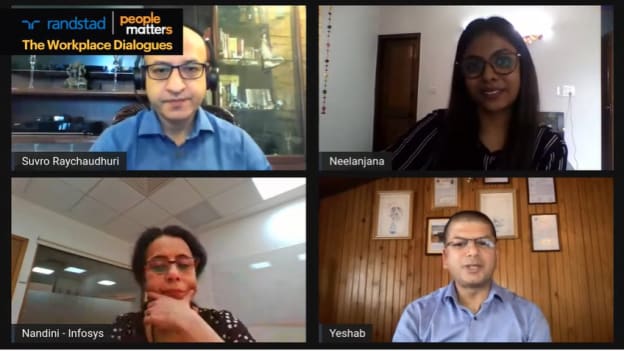Panel Session: Recrafting employee experience for the Indian IT Industry

The talent landscape has changed with emerging workplace expectations and constantly changing work dynamics. Candidates today are looking beyond pay when joining an organization. Hence, a more holistic approach including the leadership style, culture, vision-mission towards employee experience is required.
When organizations get the employee experience right, they can achieve twice the customer satisfaction and innovation, and generate more than 25% higher profits than those who do not make these investments - Yeshab Giri, Chief Commercial Officer - Staffing & RT Professionals, Randstad India.
Naturally, 92% of organizations are prioritizing employee experience enhancements over the next three years.
The changing landscape of the employee experience
Nandini S, Senior VP& Group Head OD, Infosys, elaborates how employees today are looking at how organizations are creating value for their long-term careers, and enabling them to become more relevant and skilled. Even with the great attrition, employees are willing to trade-off compensation with the right knowledge-building avenues. To make employees think to stay back, the right employee ecosystem must be made, such as moving people into emerging areas and giving career thrusts for high performers.
Suvro Raychaudhuri, Director HR, APAC, Solutions Delivery Centre, CGI, resonates how employee experience is all about ‘rethinking the way with antifragility
and going back to basics. Agile actions revolving around respectful environment and applied learning experiences will help create strong foundations.
Such a shift demands change of behaviours, mindsets, and hyper-personalized engagement using data.
At the crossroads of technology interventions and humane considerations post a black-swan event like the pandemic, employee experience gets recreated – Suvro.
How to drive employee experience?
Infosys focuses on ‘how to make it better for employee’ through a two-pronged approach to tackle retention:
Driving value through careers and capabilities and assessing personal readiness, for example instated a “Digital Quotient” indicator score for digital readiness.
Health and wellness support system by helping people find stress busters, family wellness through vaccination programs, etc.
At the core lies an effort to give employee choice i.e. a bouquet of offerings on the career side with avenues and enablers.
At CGI, the ability to manage the dynamic IT workforce goes hand in hand with business continuity, through a tech-enabled, metrics-forward approach. HR started measuring commitment levels with two lenses:
By aligning customer experience with employee experience: The customer satisfaction and member satisfaction scores gap has reduced progressively standing at a difference of 0.3.
Providing employees a bouquet and allowing employees to choose by using Big Data to know the needs, wants, wishes and aspirations of different employee groups.
The challenge is real, as Nandini says, “Offer different things to different groups based on career needs, learning needs, health and wellness needs, flexibility needs, etc.”. Suvro emphasizes how change of behaviour needs to be driven. “We have done workshops for encouraging crucial conversations and placing the onus on managers to correct their behaviours”.
Randstad too started initiatives around ergonomic cost reimbursements (Be Kind to your Body Program), Employee Mental Health and Wellness program (Be Kind To Your Mind), flexible working hours, virtual town halls and carnivals, radio shows, talent hunts and no-meeting Fridays.
A culture shift: humanizing the digital employee experience
As organizations plan the ‘return to work’ with a hybrid model, HR must work towards building balance. On one hand Infosys plans to have new policies to help managers hire people at different locations, but this should also factor in individuals’ willingness, discretion, flexibility needs and teams’ context. “If it is an engaging and interesting initiative, people will come forward. Let employees decide when they want to consume, what they want to consume, and even if they want to consume”, shares Nandini. Suvro reiterates, “At CGI, we made a mobile app to help us through the day’s activities, to help disconnect as required and bring in peace, stability and inner voice; to push noise away and allow signals in”.
A knowledge environment is about giving people platforms, testing the platforms, and giving them discretionary wishes to come in. HR has a responsibility to create the right environment by making people more self-aware and connecting them to the platforms both physically and mentally. Not just HR, business leaders must be able to establish trust between employee and employer. They must embrace vulnerability i.e. be able to accept that people have limitations, and that ordinary mortals can do extraordinary work. A culture that helps people candidly discuss vulnerability opens human psychology security, which allows for an open dialogue and in turn, an improved employee experience. This is the next-generation people-priority.
“Transition from human resources to humane resources is the way ahead”, as Yeshab mentions.
You can also watch the session here.














